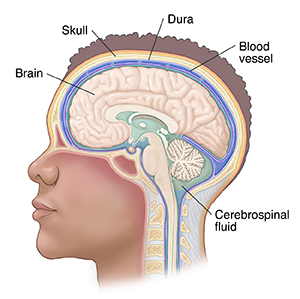Understanding Craniectomy
A craniectomy is a surgery to remove a piece of your skull. It’s done to help ease pressure in the skull when fluid builds up and presses on the brain. This buildup of fluid is dangerous. It can lead to brain damage or even death if not treated.
Why craniectomy is done
Your brain sits inside a bony skull. The bones of the skull help protect your brain. Inside your skull are several layers of tissue called the meninges. These layers cover and protect the brain. The layer just inside the skull is called the dura mater, or just dura. It's a tough, fibrous layer of tissue.
During a head injury, blood vessels in the brain may break open and bleed into any of these layers. Swelling and inflammation may also increase fluid in the area. The blood and other extra fluid increases pressure inside the skull. This can press on the brain and damage it. It can lead to loss of consciousness, brain damage, coma, and death. A craniectomy is done to ease the pressure on the brain.
Head injury is not the only cause of pressure on the brain from fluid. You may need a craniectomy if you have:
Your healthcare provider may first try to reduce brain pressure in other ways. This may include using medicines to decrease swelling. Or it may include draining cerebrospinal fluid. This is the fluid that surrounds your brain and spinal cord. Your healthcare providers will watch your symptoms and the pressure inside your skull. If the pressure isn’t too high, the risks of the surgery may outweigh the benefits.

How craniectomy is done
The surgery is done by a neurosurgeon. This is a healthcare provider who has special training to do brain or spinal cord surgery. The surgeon will make a cut (incision) in your scalp. This is often done on the side of the skull with the most pressure. The surgeon will use a drill and saw to remove a piece of your skull. The healthcare team will carefully store the piece of skull. The surgeon will make a cut in the membranes that surround your brain. They will do repairs as needed. A mesh piece may be placed over the area. This is to help protect the brain. A few weeks later, the surgeon will put back the piece of skull or a synthetic material. This is done under anesthesia through the previous incision.
Risks of craniectomy
All surgery and anesthesia have risks. The risks of craniectomy include:
-
Infection (meningitis or brain abscess)
-
Seizures
-
More brain injury
-
Bleeding around the brain membranes (meninges)
-
Buildup of cerebrospinal fluid (hydrocephalus)
-
Blood clot or heart attack
-
Problems from anesthesia
Some of these can result in coma and death. There is also a risk that the craniectomy will not be able to stop brain damage.
The healthcare provider will only advise a craniectomy if the benefits are greater than the risks. Your own risks may differ depending on the reason for the surgery, your age, and your overall health. Talk with your provider to find out what risks may apply to you.